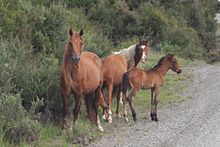
The tarpan was a free-ranging horse population of the Eurasian steppe from the 18th to the 20th century. What qualifies as a tarpan is subject to confusion. It is unknown whether those horses represented genuine wild horses, feral domestic horses or hybrids. The last individual believed to be a tarpan died in captivity in the Russian Empire in 1909.
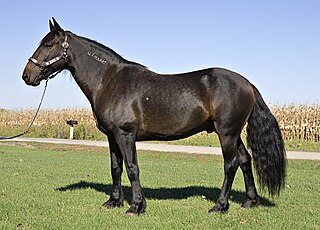
The mustang is a free-roaming horse of the Western United States, descended from horses brought to the Americas by the Spanish conquistadors. Mustangs are often referred to as wild horses, but because they are descended from once-domesticated animals, they are actually feral horses. The original mustangs were Colonial Spanish horses, but many other breeds and types of horses contributed to the modern mustang, now resulting in varying phenotypes. Some free-roaming horses are relatively unchanged from the original Spanish stock, most strongly represented in the most isolated populations.

Colonial Spanish horse is a term for a group of horse breed and feral populations descended from the original Iberian horse stock brought from Spain to the Americas. The ancestral type from which these horses descend was a product of the horse populations that blended between the Iberian horse and the North African Barb. The term encompasses many strains or breeds now found primarily in North America. The status of the Colonial Spanish horse is considered threatened overall with seven individual strains specifically identified. The horses are registered by several entities.
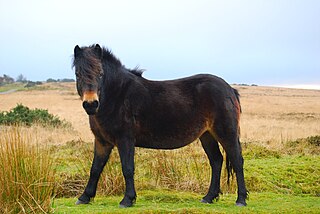
The Exmoor Pony is a British breed of pony or small horse. It is one of the mountain and moorland pony breeds native to the British Isles, and so falls within the larger Celtic group of European ponies. It originates on, and is named for, the Exmoor area of moorland in north-eastern Devon and western Somerset, in south-west England, and is well adapted to the climate conditions and poor grazing of the moor. Some still live there in a near-feral state, but most are in private ownership.

The Spanish Mustang is an American horse breed descended from horses brought from Spain during the early conquest of the Americas. They are classified within the larger grouping of the Colonial Spanish horse, a type that today is rare in Spain. By the early 20th century, most of the once-vast herds of mustangs that had descended from the Spanish horses had been greatly reduced in size. Seeing that these horses were on the brink of extinction, some horseman began making efforts to find and preserve the remaining "Spanish Mustangs" drawing stock from feral and Native American herds, as well as ranch stock. The breed was one of the first to be part of a concerted preservation effort for horses of Spanish phenotype, and a breed registry was founded in 1957.

The Nokota horse is a feral and semi-feral horse breed located in the badlands of southwestern North Dakota in the United States. The breed developed in the 19th century from foundation stock consisting of ranch-bred horses produced from the horses of local Native Americans mixed with Spanish horses, Thoroughbreds, harness horses and related breeds. The Nokota was almost wiped out during the early 20th century when ranchers, in cooperation with state and federal agencies, worked together to reduce competition for livestock grazing. However, when Theodore Roosevelt National Park was created in the 1940s, a few bands were inadvertently trapped inside, and thus were preserved.
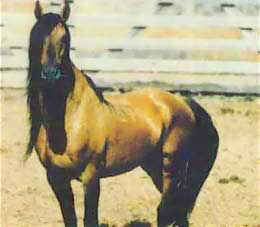
The Kiger mustang is a strain of mustang horse located in the southeastern part of the U.S. state of Oregon. The name applies only to wild-captured individuals and does not apply to their bred-in-captivity progeny, which are known as Kiger horses. The Bureau of Land Management (BLM) administers two herd management areas for Kiger mustangs in the Burns District—Kiger and Riddle Mountain, in the Steens Mountain area. DNA testing has shown that Kiger mustangs are descended largely from Spanish horses brought to North America in the 17th century, a bloodline thought to have largely disappeared from mustang herds before the Kiger horse populations were discovered in 1977.

A brumby is a free-roaming feral horse in Australia. Although found in many areas around the country, the best-known brumbies are found in the Australian Alps region. Today, most of them are found in the Northern Territory, with the second largest population in Queensland. A group of brumbies is known as a "mob" or "band".

A semi-feral animal lives predominantly in a feral state but has some contact and experience with humans. This may be because it was born in a domesticated state and then reverted to life in wild conditions, or it may be an animal that grew up in essentially wild conditions but has developed a comfort level with humans through feeding, receiving medical care, or similar contacts.
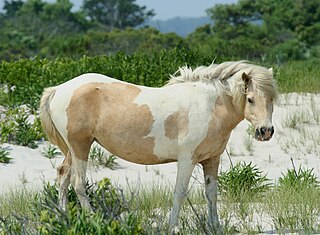
The Chincoteague pony, also known as the Assateague horse, is a breed of horse that developed, and now lives, within a semi-feral or feral population on Assateague Island in the US states of Virginia and Maryland. The Chincoteague pony is one of the many breeds of feral horses in the United States. The breed was made famous by the Misty of Chincoteague novels, written by pony book author Marguerite Henry, and first published in 1947, and the pony Misty of Chincoteague.

A feral horse is a free-roaming horse of domesticated stock. As such, a feral horse is not a wild animal in the sense of an animal without domesticated ancestors. However, some populations of feral horses are managed as wildlife, and these horses often are popularly called "wild" horses. Feral horses are descended from domestic horses that strayed, escaped, or were deliberately released into the wild and remained to survive and reproduce there. Away from humans, over time, these animals' patterns of behavior revert to behavior more closely resembling that of wild horses. Some horses that live in a feral state but may be occasionally handled or managed by humans, particularly if privately owned, are referred to as "semi-feral".
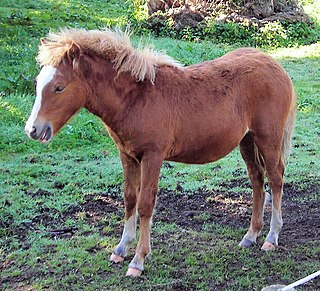
The Kerry Bog Pony is a mountain and moorland breed of pony that originated in Ireland. Possibly descended from the Irish Hobby horse, it originally lived a mainly feral existence in the peat bogs of what is now County Kerry in southwestern Ireland. Local inhabitants used the ponies as pack and cart horses for transporting peat and kelp to the villages. The breed developed physical characteristics including a low weight-to-height ratio and an unusual footfall pattern, which helped it move on soft ground such as peat bogs. The ponies were known for hardiness and an ability to survive in harsh conditions.

Mountain and moorland ponies form a group of several breeds of ponies and small horses native to the British Isles. Many of these breeds are derived from semi-feral ponies kept on moorland or heathland, and some of them still live in this way, as well as being kept as fully domesticated horses for riding, driving, and other draught work, or for horse showing.
The Coffin Bay Pony is a semi-feral horse that developed in Australia. These ponies evolved from foundation bloodstock of 60 Timor Ponies that were imported by English settlers from Indonesia to Coffin Bay, on the southern tip of the Eyre Peninsula at Coffin Bay, South Australia. Coffin Bay Ponies are often confused with Australia's most noted feral horses, the Brumby, which lives in wild mobs all over Australia. However, Coffin Bay ponies live in a fenced protected area.
The Pryor Mountains Wild Horse Range is a refuge for a historically significant herd of free-roaming mustangs, the Pryor Mountain mustang, feral horses colloquially called "wild horses", located in the Pryor Mountains of Montana and Wyoming in the United States. The range has an area of 39,650 acres (160.5 km2) and was established in 1968 along the Montana–Wyoming border as the first protected refuge dedicated exclusively for mustangs. It was the second feral horse refuge in the United States. About a quarter of the refuge lies within the Bighorn Canyon National Recreation Area. A group of federal agencies, led by the Bureau of Land Management, administers the range.

The Pryor Mountain mustang is a substrain of mustang considered to be genetically unique and one of the few strains of horses verified by DNA analysis to be descended from the original Colonial Spanish horses brought to the Americas by the Spanish. They live on the Pryor Mountains Wild Horse Range located in the Pryor Mountains of Montana and Wyoming in the United States, and are the only mustang herd remaining in Montana, and one of sixteen in Wyoming. They are protected by the Wild and Free-Roaming Horses and Burros Act of 1971 (WFRHBA) and managed by the Bureau of Land Management (BLM), who has set the optimum herd number at 120 animals. Genetic studies have revealed that the herd exhibits a high degree of genetic diversity and a low degree of inbreeding, and BLM has acknowledged the genetic uniqueness of the herd. Pryor Mountain Mustangs are relatively small horses, exhibit a natural ambling gait, and domesticated Pryor Mountain mustangs are known for their strength, sure-footedness and stamina. The Pryor Mountains Wild Horse Range is one of the most accessible areas to view feral horse herds in the United States and tourism to the area has increased in recent years.

The Cumberland Island horses are a band of feral horses living on Cumberland Island in the state of Georgia. Popular myth holds that horses arrived on the island sometime in the 16th century with the arrival of the Spanish conquistadors. However, it is unlikely that any horses left by the Spanish survived, and more likely the current population descends from horses brought to the island in the 18th century by the English. Cumberland Island became part of the Cumberland Island National Seashore in 1972 when the National Park Service (NPS) took over its management. These horses are similar to the bands of horses living on the islands of Chincoteague and Assateague. There is estimated to be a population of between 150 and 200 horses on the island. Horses on Cumberland Island have a relatively short life expectancy, due to pest infestations, disease and their rugged environment. In 2000 a behavioral study found that instability marks the bands, with large numbers of co-dominant stallions, early dispersal of juveniles, and frequent band-changing among mares.
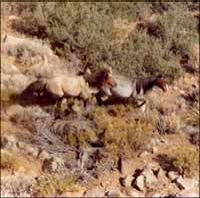
The Cerbat mustang is a feral horse population of Arizona, found in the Cerbat Herd Management Area in that state. Their main coat colors are chestnut, bay, and roan. While their phenotype is similar to the classic Colonial Spanish horse, the actual origin of Cerbat mustangs is unclear, but they have been identified by DNA testing as of Colonial Spanish horse ancestry, and they are recognized by the Spanish Mustang registry as valid foundation stock for that standardized breed. Cerbats possess the ability to gait.

Mary Etherington was an English horse breeder from Withypool credited with reviving the Exmoor pony population after World War II. She and her husband, James Grant Speed (1906-1980) co-founded the Exmoor Pony Trekking Society at the Royal (Dick) School of Veterinary Studies now part of the University of Edinburgh.

The Ojibwe Horse, also known as the Lac La Croix Indian Pony and Lac La Croix “Indian” or “Indigenous” pony is a semi-feral Canadian horse breed developed by the Ojibwe people. The population became critically low; and, by 1977, only four mares remained. To preserve the breed, these mares were crossed with Spanish Mustang stallions. The modern breed name derives from the Lac La Croix First Nation of Ontario, where the horses were last found in the wild. Historically, the breed was also found in Minnesota.
